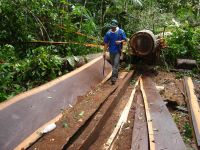 In Janine Benyus’s world, architects, car manufacturers, furniture makers and engineers don’t look to computers to solve design challenges - they look outside their windows.
In Janine Benyus’s world, architects, car manufacturers, furniture makers and engineers don’t look to computers to solve design challenges - they look outside their windows.
The natural sciences writer, innovation consultant, and author proposes that the most inspiring ideas come from what we imitate in nature, not what we extract from it. This philosophy has earned her multiple accolades, including 2009 UNEP Champion of the Earth and Time International Hero of the Environment
Through her childhood abode in a woodsy town in New Jersey, to her current home in the mountainous state of Montana, Janine has cultivated a deep knowledge of the natural world:
"A sustainable world already exists, in the prairies, forests, tundras, and coral reefs of our planet. The search for solutions to problems like climate change should start here, emulating life-enhancing technologies that have been field tested for 3.8 billion years.”
Biomimicry – a discipline popularized by Benyus – studies nature's best ideas and imitates these designs and processes to solve human problems. The word comes from bios, meaning life, and mimesis, meaning to imitate.
The core idea is that nature, imaginative by necessity, has already solved many of the problems we are grappling with. Animals, plants, and microbes are the niftiest engineers. They have found what works, what is appropriate, and most significantly, what lasts here on Earth.
If this seems like a far-flung treehugger’s nirvana, consider the following examples of biomimicry at work:
Dolphins: Blue-Finned Weather Monitors
 Some 225,000 people died in the Sumatran tsunami in 2004. The difficulty is detecting tsunamis early enough to warn people, because tsunami waves dozens of feet high when they reach the shore may only be a few dozen centimeters high as they travel through the deep ocean. In order to reliably detect them and warn people before they reach land, sensitive pressure sensors must be located underneath passing waves in waters as deep as 6000 meters. The sensor data must then be transmitted up to a buoy at the water’s surface, where it is relayed to a satellite for distribution to the early warning center. Transmitting data through miles of water has proven difficult, however: sound waves, while unique in being able to travel long distances through water, reverberate and can destructively interfere with one another as they travel, compromising the accuracy of information.
Some 225,000 people died in the Sumatran tsunami in 2004. The difficulty is detecting tsunamis early enough to warn people, because tsunami waves dozens of feet high when they reach the shore may only be a few dozen centimeters high as they travel through the deep ocean. In order to reliably detect them and warn people before they reach land, sensitive pressure sensors must be located underneath passing waves in waters as deep as 6000 meters. The sensor data must then be transmitted up to a buoy at the water’s surface, where it is relayed to a satellite for distribution to the early warning center. Transmitting data through miles of water has proven difficult, however: sound waves, while unique in being able to travel long distances through water, reverberate and can destructively interfere with one another as they travel, compromising the accuracy of information.
Unless, that is, you are a dolphin.
Dolphins are able to recognize the calls of specific individuals, or ‘signature whistles’, up to 25 kilometers away, demonstrating their ability to communicate and process sound information accurately despite the challenging medium of water. By employing several frequencies in each transmission, dolphins have found a way to cope with the sound scattering behavior of their high frequency, rapid transmissions, and still get their message reliably heard. Emulating dolphins’ unique frequency-modulating acoustics, engineers have developed a high-performance underwater modem for data transmission, which is currently employed in the tsunami early-warning system throughout the Indian Ocean.
“100% Effective Washing Detergent! Now Infused With…Lotus?”
Ask any school child or adult how leaves keep water from sticking to them, and they’ll almost certainly say, “Because they are so smooth.” Yet one of the most water repellent leaves in the world, that of the Lotus (Nelumbo nucifera), isn’t smooth at all; it has one of the most microscopically rough leaf surfaces imaginable.
Instead, water that falls on the leaf of the lotus plant “floats” on a maze of air trapped in the myriad crevices of the leaf surface, so that the slightest breeze or tilt in the leaf causes balls of water to just roll off, taking attached dirt particles with them.
Now, microscopically rough surface additives have been introduced into a new generation of paint, glass, ceramic and other finishes, greatly reducing the need for chemical or laborious cleaning. For example, GreenShield, a fabric finish inspired by lotus leaves, achieves the same performance as conventional finishes while using eight times less harmful chemicals.
Termite-Engineering
We generally think of termites as destroying buildings, not helping design them. But the Eastgate building, an office complex in Harare, Zimbabwe, has an air conditioning system modeled on the self-cooling mounds of Macrotermes michaelseni, termites that maintain the temperature inside their nest to within one degree, day and night (while the temperature outside swings from 42 °C to 3 °C.
The operation of buildings represents 40 per cent of all the energy used by humanity, so learning how to design them to be more sustainable is crucial.
Architect Mick Pearce collaborated with engineers at Arup Associates to design Eastgate, which uses 90 per cent less energy for ventilation than conventional buildings its size, and has already saved the building owners over $3.5 million dollars in air conditioning costs.
Learn more about the fascinating world of biomimicry here: http://www.biomimicryinstitute.org/





























 In Janine Benyus’s world, architects, car manufacturers, furniture makers and engineers don’t look to computers to solve design challenges - they look outside their windows.
In Janine Benyus’s world, architects, car manufacturers, furniture makers and engineers don’t look to computers to solve design challenges - they look outside their windows. Some 225,000 people died in the Sumatran tsunami in 2004. The difficulty is detecting tsunamis early enough to warn people, because tsunami waves dozens of feet high when they reach the shore may only be a few dozen centimeters high as they travel through the deep ocean. In order to reliably detect them and warn people before they reach land, sensitive pressure sensors must be located underneath passing waves in waters as deep as 6000 meters. The sensor data must then be transmitted up to a buoy at the water’s surface, where it is relayed to a satellite for distribution to the early warning center. Transmitting data through miles of water has proven difficult, however: sound waves, while unique in being able to travel long distances through water, reverberate and can destructively interfere with one another as they travel, compromising the accuracy of information.
Some 225,000 people died in the Sumatran tsunami in 2004. The difficulty is detecting tsunamis early enough to warn people, because tsunami waves dozens of feet high when they reach the shore may only be a few dozen centimeters high as they travel through the deep ocean. In order to reliably detect them and warn people before they reach land, sensitive pressure sensors must be located underneath passing waves in waters as deep as 6000 meters. The sensor data must then be transmitted up to a buoy at the water’s surface, where it is relayed to a satellite for distribution to the early warning center. Transmitting data through miles of water has proven difficult, however: sound waves, while unique in being able to travel long distances through water, reverberate and can destructively interfere with one another as they travel, compromising the accuracy of information.

